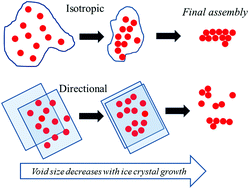Colloidal assembly by directional ice templating†
Abstract
We investigate directional ice templating of dilute aqueous colloidal particle dispersions and examine the nature of the assemblies that result. We coat micron-size polystyrene colloids with cross-linkable polymer (polyethyleneimine, PEI), add cross-linker, and subject this dispersion to unidirectional freezing. We work at sufficiently low colloid concentrations, such that the particles do not percolate on freezing. When the aqueous dispersion freezes, ice crystals force polymer-coated particles and cross-linker into close proximity. This results in the formation of cross-linked clusters of particles at ice crystal boundaries. We vary the particle volume fraction from φ ∼ 2.5 × 10−3 to φ ∼ 5.0 × 10−2 and observe that there is a transition from isolated single particles to increasingly large sized clusters. Most of the clusters formed under these conditions are either linear, two-particle wide chains, or sheet-like aggregates. The probability (Pn) of clusters containing n particles (n > 2) obeys a power law Pn ∼ n−η, where η strongly depends on the particle concentration in the dispersion, varying from 2.10 (for φ ∼ 5.0 × 10−2) to 3.03 (for φ ∼ 2.5 × 10−3). This change in η is qualitatively different from the case of isotropic freezing, where η is particle concentration-independent and depends only on the ice nucleation density. To understand the differences between isotropic and directional ice templating, we performed lattice simulations of a highly simplified model, where ice crystals grow at a constant rate to force clustering. We ignore hydrodynamic interactions and ice growth instabilities. Despite ignoring these experimental details, the simulations capture the experimental results, nearly quantitatively. As the ice crystals grow and the space available to the colloids “closes up” so that the particles cluster to form aggregates, crystallization protocol-induced differences in the geometry of these “closed up” spaces determine the scaling behaviour of Pn.



 Please wait while we load your content...
Please wait while we load your content...